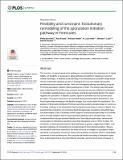| dc.contributor.author | Laub, Michael T | |
| dc.date.accessioned | 2020-05-26T16:18:12Z | |
| dc.date.available | 2020-05-26T16:18:12Z | |
| dc.date.issued | 2018-09 | |
| dc.identifier.issn | 1553-7404 | |
| dc.identifier.issn | 1553-7390 | |
| dc.identifier.uri | https://hdl.handle.net/1721.1/125451 | |
| dc.description.abstract | The evolution of signal transduction pathways is constrained by the requirements of signal fidelity, yet flexibility is necessary to allow pathway remodeling in response to environmental challenges. A detailed understanding of how flexibility and constraint shape bacterial two component signaling systems is emerging, but how new signal transduction architectures arise remains unclear. Here, we investigate pathway remodeling using the Firmicute sporulation initiation (Spo0) pathway as a model. The present-day Spo0 pathways in Bacilli and Clostridia share common ancestry, but possess different architectures. In Clostridium acetobutylicum, sensor kinases directly phosphorylate Spo0A, the master regulator of sporulation. In Bacillus subtilis, Spo0A is activated via a four-protein phosphorelay. The current view favors an ancestral direct phosphorylation architecture, with the phosphorelay emerging in the Bacillar lineage. Our results reject this hypothesis. Our analysis of 84 broadly distributed Firmicute genomes predicts phosphorelays in numerous Clostridia, contrary to the expectation that the Spo0 phosphorelay is unique to Bacilli. Our experimental verification of a functional Spo0 phosphorelay encoded by Desulfotomaculum acetoxidans (Class Clostridia) further supports functional phosphorelays in Clostridia, which strongly suggests that the ancestral Spo0 pathway was a phosphorelay. Cross complementation assays between Bacillar and Clostridial phosphorelays demonstrate conservation of interaction specificity since their divergence over 2.7 BYA. Further, the distribution of direct phosphorylation Spo0 pathways is patchy, suggesting multiple, independent instances of remodeling from phosphorelay to direct phosphorylation. We provide evidence that these transitions are likely the result of changes in sporulation kinase specificity or acquisition of a sensor kinase with specificity for Spo0A, which is remarkably conserved in both architectures. We conclude that flexible encoding of interaction specificity, a phenotype that is only intermittently essential, and the recruitment of kinases to recognize novel environmental signals resulted in a consistent and repeated pattern of remodeling of the Spo0 pathway. | en_US |
| dc.description.sponsorship | Human Frontier Science Program (Strasbourg, France) (Grant RGP0043/2013) | en_US |
| dc.language.iso | en | |
| dc.publisher | Public Library of Science (PLoS) | en_US |
| dc.relation.isversionof | https://dx.doi.org/10.1371/JOURNAL.PGEN.1007470 | en_US |
| dc.rights | Creative Commons Attribution 4.0 International license | en_US |
| dc.rights.uri | https://creativecommons.org/licenses/by/4.0/ | en_US |
| dc.source | PLoS | en_US |
| dc.title | Flexibility and constraint: Evolutionary remodeling of the sporulation initiation pathway in Firmicutes | en_US |
| dc.type | Article | en_US |
| dc.identifier.citation | Davidson, Philip et al. “Flexibility and constraint: Evolutionary remodeling of the sporulation initiation pathway in Firmicutes.” PLOS genetics 14 (2018): e1007470 © 2018 The Author(s) | en_US |
| dc.contributor.department | Massachusetts Institute of Technology. Department of Biology | en_US |
| dc.relation.journal | PLOS genetics | en_US |
| dc.eprint.version | Final published version | en_US |
| dc.type.uri | http://purl.org/eprint/type/JournalArticle | en_US |
| eprint.status | http://purl.org/eprint/status/PeerReviewed | en_US |
| dc.date.updated | 2020-01-23T16:16:37Z | |
| dspace.date.submission | 2020-01-23T16:16:41Z | |
| mit.journal.volume | 14 | en_US |
| mit.journal.issue | 9 | en_US |
| mit.metadata.status | Complete | |
